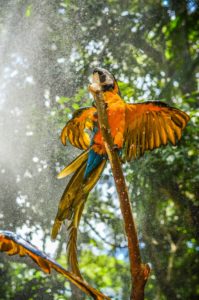Conservation and Biodiversity
Climate change can tear ecosystems apart, warns Amazon rainforest expert
September 5, 2019
Climate change is threatening our wildlife, and nowhere is that more apparent than the Amazon rainforest.
As the largest rainforest in the world, the Amazon spans 2.3 million square miles (twice the size of India) and has within its borders the world’s largest river basin. It’s also one of the richest biological communities, home to 10 percent of the world’s known species, as well as many flora and fauna unique to the region.
But if we don’t shape up — and by shape up, we mean slash greenhouse gas emissions at a rapid pace — we might lose this vast empire of wildlife.
“It is very clear that climate change of more than one and a half degrees [Celsius] will produce a climate that’s very difficult to manage biologically,” says Thomas Lovejoy, senior fellow at the United Nations Foundation, in an interview with Earth Day Network. “Basically, ecosystems are already starting to come apart, some of them quite dramatically.”

The Amazon is suffering from the influence of human activities, most recently in the news through coverage of deforestation and fires. And global warming, induced by the huge amounts of carbon dioxide being released into the atmosphere, is making everything worse, especially for all those diverse species.
Still, as Lovejoy points out, for the billions of years before humans discovered fossil fuels, the Earth has maintained balance by regulating carbon dioxide in the atmosphere. Lovejoy refers to these interacting processes — processes that incorporate ecosystems and climate as interworking parts — as a living planet.
“It’s time to start treating, respecting and managing the planet as the living system that it is, that it is a linked physical and biological system,” he says.
Basically, ecosystems are already starting to come apart, some of them quite dramatically.
Thomas Lovejoy
Lovejoy has been nicknamed “the Godfather of Biodiversity” for his extensive work in biology within the Amazon rainforest. Biodiversity is, according to Lovejoy, “the variety of nature. Whether you think in species or different kinds of habitats or genetic diversity of a species, it’s the variation of nature.”
He says that biodiversity is the best way to measure the health of our planet. Basically, wildlife is the canary of not only coal mines, but the entire planet. It’s important to therefore respect the Earth’s biological working parts, because if we don’t, it could spell disaster.
And the quicker we embrace this idea and start embracing solutions, the better, because the Amazon may be on the verge of a tipping point, where natural systems start working against each other with cascading effects. How water is distributed across the Amazon and South America is one factor vulnerable to this tipping point.

The Amazon is so large that it has its own hydrological cycle. As rain falls onto the forest, the vegetation absorbs the water and then releases it back into the air through evapotranspiration. The recent Amazon wildfires, driven partially by deforestation, could upend that process. And a drier Amazon, which should be one of the wettest places in the world, would have terrible consequences on ecosystems.
With historic droughts more and more frequently in the last decade, Lovejoy thinks we might already be seeing the telltale signs of the tipping point. But that doesn’t mean we can’t work together to find solutions. And it starts with biodiversity restoration.
Lovejoy cites several ways to help this living planet, starting with ecosystem restoration. Lovejoy calls it “re-greening the planet.” It can be planting a tree or helping restore a coastal wetland, he says.
Additionally, we need to transform our agricultural systems so that they absorb, rather than produce, carbon. And, as has been in the news lately, cattle ranching is a major drive of deforestation in the Amazon, so considering a plant-based diet doesn’t hurt.
“[Biodiversity restoration] will require greater vision, collective vision, about the future of the planet than has been our usual way of doing it,” says Lovejoy. “The only way out of this is to think big and at the same time think about what it means for individuals and how they can contribute.”
